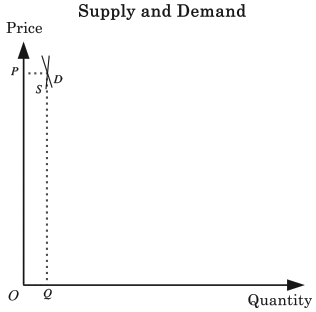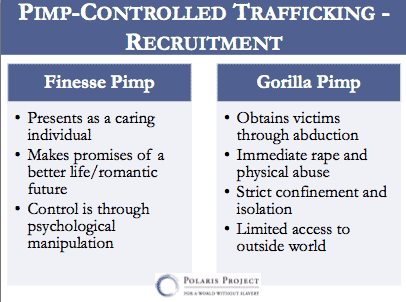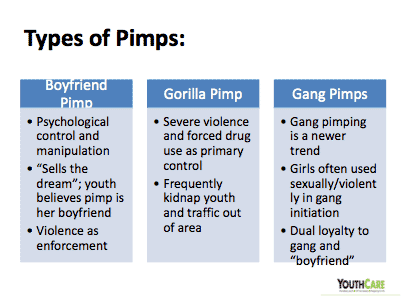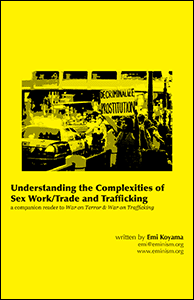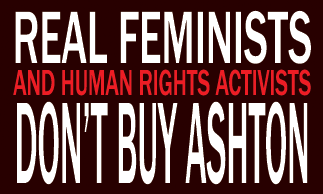“End demand” approach to addressing human trafficking continues to gain traction, as law enforcement agencies across the country hold the third “National Day of Johns Arrests.” The 10-day simultaneous campaign against alleged buyers of sex is led by Cook County Sheriff Tom Dart, who claims that 66 johns have been arrested in Cook County alone.
Of course, Sheriff Dart’s claim is dubious, considering the fact that Chicago (which is in Cook County) Police Department routinely misclassifies trans women (frequently young trans women of color) who have been arrested for selling sex as “buyers”: as of this writing, the Chicago PD lists 36 “sex buyers” on its website dedicated to publicly humiliating alleged “sex buyers,” of whom 7 are clearly dressing as women (and a couple more appear gender-ambiguous).
I have in the past pointed out why “end demand” policies are harmful to people who work in the sex trade, and even provided a further explanation for the economics of “end demand” policies. But recently I had an online exchange with someone who goes by the name “uncorrelated” and seems to know a lot more about development economics than I do that helped me explore a possibility that I have hinted before but did not feel confident enough to articulate, because it appeared to go against basic economic theories which I have not been formally trained in anyway.
But after my conversations with “uncorrelated,” I am now prepared to make an unconventional and counter-intuitive claim: that “end demand” approach to prostitution, which seeks to reduce demand for commercial sex through public education, prosecution, public humiliation, and other means, may increase prostitution, rather than decrease it, under certain (realistic) conditions.
There are two important assumptions for this claim to be true. First, I assume that prostitution market has extremely low (or negative) downward price elasticity of supply, particularly at the lower end of the market (it makes sense to focus on the lower end, because prostitution market is highly segmented and people at the lower end are the ones most vulnerable to abuse and exploitation), because of lack of viable economic alternatives. Second, I assume that people who trade sex face a trade-off between generating income through sex trade and spending time and energy doing other activities (child-raising, family, community, school, leisure, etc.).
Elasticity is the degree to which changes in one economic variable (such as price) can affect another (such as demand). It is calculated as the ratio of percentage change of the variable that is affected to that of the variable that is manipulated: for example, price elasticity of demand (i.e. degree to which demand is affected by the changes in the price) is calculated as (the change in demand):(the change in price). If a 20% increase in price for a particular product resulted in a 20% decrease in demand, the price elasticity of that product is 1; on the other hand, if the same price increase only caused a 10% decrease in demand, the elasticity is 0.5.
Proponents of “end demand” policies implicitly presume normal (high) elasticity in prostitution market: that is, they believe that a reduction in demand would be met with a comparable reduction in supply, arbitrated by the lower price for sex. Below is a supply and demand chart that presumes normal elasticity.
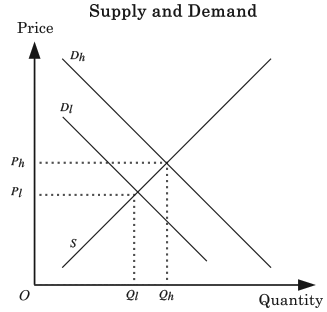
Dh and Dl are demand curves (although I’ve made them linear lines for the sake of simplicity) corresponding to high and low demand scenarios. Where the demand curve intersects with the supply curve (represented by the line labeled S) determines the price for which sex is traded, and the quantity of sex traded. The chart indicates that reduction of demand (shifting from Dh to Dl) lowers both price and quantity of commercial sex.
But the supply side of prostitution market (people in the sex trade) are often there in the first place because they lack other viable or comparable economic options, and the reduction of the demand (and hence the price of sex) does not change that circumstance. If many sellers of sex do not have comparable alternatives to selling sex, they will be stuck trading sex for money even if the demand (and hence the price) goes down. That is, supply in prostitution market is downwardly inelastic.
The supply and demand chart below demonstrates this inelasticity of supply. Since price elasticity of supply is defined as the ratio of change in supply to the change of price, lower elasticity can be represented by a more steep supply curve.
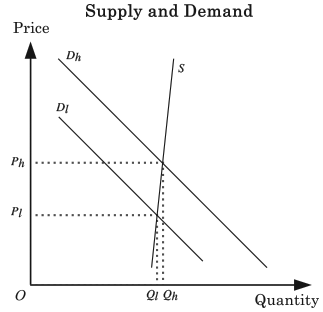
This chart shows the same high and low demand curves, but the supply curve has been modified to reflect a lower price elasticity of supply. Compared to the first chart, this chart shows a more drastic drop in the trading price of sex, and much smaller decrease in the quantity of sex traded. That would mean that prostitution would become far less profitable but not much less prevalent.
A more extreme version of this scenario is the one in which (virtually) none of the people currently in the sex trade have viable alternatives (which, many anti-prostitution activists argue is the case). If none of them could find other sources of income, the supply elasticity would equal zero, which would look like this:
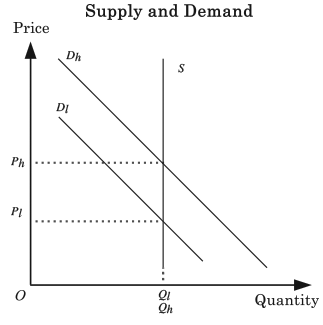
In the “zero elasticity” scenario, the level of demand (and hence the price) is irrelevant to the level of supply, because people are dependent on having income from it. Of course if the reduction in demand is more extreme–to the point they can’t find any buyers for sexual services at a price that is more profitable than, say, panhandling–there will be no supply whatsoever. But within reason, lower demand would only result in lower income and equal quantity of prostitution in the zero elasticity scenario.
Zero elasticity scenario may seem extreme and unrealistic, but it is not, especially when we are limiting our discussion to the lower end of the prostitution market. In fact, under certain circumstances elasticity can even be negative relative to what is generally expected: that is, a decrease in demand (and hence price) can lead to an increase (rather than decrease) in supply.
As counter-intuitive as it may be, this phenomenon is not unheard of in the field of development economics. For example, when the wage (price of labor) declines in a developing nation, families may try to compensate for the lower hourly wage by working longer hours, even sending children to work alongside adults rather than to school. Similarly, economists have observed that “fair trade” initiatives designed to increase payments to farmers in the developing nations for agricultural exports have sometimes resulted in these farmers working less hours–which may be a good thing if it makes them healthier or give their children opportunities to go to school. (See the chapter two of Development Microeconomics by Pranab Bardhan and Christopher Udry.)
This occurs because households face a different set of economic incentives compared to corporations. Corporations can hire more people or fire existing employees in response to the fluctuations in the market demand, but households cannot expand or contract at will. Increasing the amount of work necessarily reduces the amount of time and energy one has for other activities such as child-raising, family, community, education, and leisure. Because of this trade-off, households (and individuals) behave differently than do corporations.
Someone who works in the sex industry also faces this trade-off: the amount they work in the sex trade is negatively correlated to the amount of time and energy they have for other activities. When the market is booming, they might be able to make ends meet with minimal amount of work, which allows them to focus their time and energy for other things; however when the market bottoms out, they might be forced to work longer hours to make ends meet, sacrificing other responsibilities (e.g. children left by themselves or with untrustworthy associates) or their health (less sleep, less leisure time).
The chart below (provided by “uncorrelated”) compares “high budget/wage” and “low budget/wage” scenarios. Uh and Ul are indifference curves that show the optimal balance between the amount of labor and the level of income (i.e. household utility) under each scenario, as determined by the household. The straight lines represent the simple correlation between the amount of work one performs and the income from that work: higher wage obviously means one can earn more for the same amount of work, hence the more steep line.
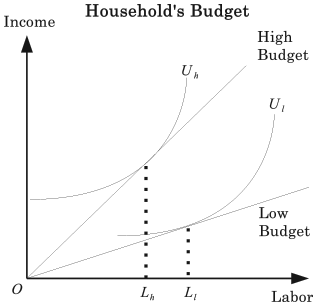
The amount of work each household decides to perform is determined at the intersection of the indifference curve and the wage line. When the price of sex decreases and the wage line shifts to the lower one, the amount of labor performed by the household goes up, from Lh to Ll, rather than going down, as predicted in a simpler economic model. If my analysis is correct, prostitution market is more like labor market in these developing nations than simpler commodity markets for things like corn and wheat.
The next chart takes into account this analysis to show what actually happens when “end demand” policies are implemented with the aim to reduce demand for commercial sex.
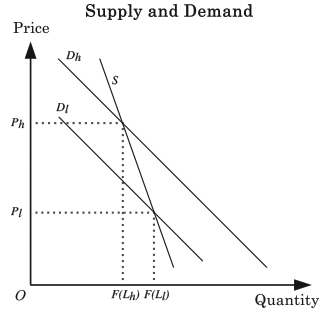
When the demand decreases from Dh to Dl, lowering the price from Ph to Pl, the supply actually increases, from F(Lh) (supply level in the high wage scenario) to F(Ll). This is the exact opposite from what proponents of “end demand” policies have implicitly presumed would happen, and yet it is the logical, economically-sound conclusion if you add to the mix two simple, entirely reasonable assumptions about the lack of alternatives and the trade-off faced by people in the sex trade.
One might challenge the first assumption on the basis that many people in the sex trade actually do have other viable economic opportunities and will flee the sex industry if the price starts to decline. That may be true for some segments of the prostitution market, but unlikely for many who are in the lower end of the market, whom I am focusing here. I also do not expect any “end demand” proponents to make this argument, since they tend not to believe that prostitution can be freely chosen work for vast majority of people who are in the sex trade.
Proponents of “end demand” policies are more likely to challenge the second premise, arguing that people in the sex trade are frequently (physically for psychologically) forced to engage in prostitution, and are not in the position to make rational, utility-maximizing decisions for themselves. But if pimps are making decisions, they would certainly not accept a lower income simply because the market has bottomed out: they would likely use greater coercion to extract even more labor and thus income from the person they are controlling. So the end result would be the same: less demand leads to more supply.
“End demand” policies should be rejected because they harm the very people they are intended to help, and does not even succeed at reducing the supply of commercial sex in the long term (and may in fact increase it). Any reduction of demand will be temporary, because as long as there are no other viable economic opportunities, the price will decrease until it reaches a level that can attract enough demand to return. And on top of that, “end demand” policies push away clients (johns) who are relatively safer to work with and draw in those who are most dangerous, as I’ve argued before. The solution to economic desperation and vulnerabilities is to address that economic injustice, not to (make failed attempts to) mask its symptoms.
Note: I am seeking economists or economics students who are interested in collaborating on pushing this analysis further. For example, I want to figure out a systematic way to test the hypothesis through creative use of public information such as online sex ads and arrest records (indicating major sweeps) city by city. This may be a publication opportunity. Please email me at emi AT eminism DOT org if you are interested… and please share this post with people you know who might be interested.





